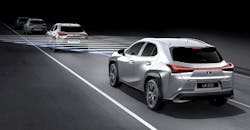Automotive repair professionals are typically aware of the potential impacts to Active Driver Assistance Systems (ADAS) sensors that may occur during a collision, but technicians today must also consider the potential unintended effects of some mechanical repairs.
Before beginning a Lexus vehicle repair, technicians must be aware of the vehicle’s convenience and safety features, and how a normal procedure might somehow disturb the position of a sensor. “Following Lexus factory-approved repair procedures is paramount”, advises Paul Williamsen, Product Education Manager, TMNA Lexus College, “and following calibration procedures after a repair is critical.”
Lexus’ Technical Information System (TIS) is the best source to access current factory information. To find calibration instructions in TIS, specify the model and model year of the vehicle and search on “calibration”. The results will lead you to the calibration procedures for the repair. If you do not currently have access to TIS, contact your local Lexus dealer for assistance.
UNINTENDED IMPACTS TO ADAS and LSS SYSTEMS CONSIDERATIONS IN MECHANICAL REPAIRLexus Safety System (LSS) and ADAS components generally do not require maintenance and are not disturbed by normal driving operation or regular vehicle service events. They are designed to work effortlessly for the entire life of the vehicle, with the exception of a collision or other event that could damage sensor function or alter sensor alignment. Many sensors perform multiple roles and a repair procedure that unintentionally alters their alignment could compromise their effectiveness.
“In many cases, a single sensor provides inputs for multiple systems–there’s a lot of complex networking that's going on inside the vehicle,” explains Williamsen. “We might look at a sensor and say, ‘that's the forward radar sensor behind the grill that's used for adaptive cruise control’ But in fact, that radar sensor is also an essential sensor for the pre-collision system—a key safety system.”
The complexity of these sensor networks can present challenges to technicians. Some examples of seemingly benign procedures that could impact proper sensor function are presented below.
Tow Hitch Receiver Installation
Lexus factory-approved tow receiver hitches are designed to be installed without impact to the vehicle’s sensors. The bumper cover encases small either ultrasonic or radar sensors that provide inputs for safety features like rear collision warning, cross traffic warning, and the advanced parking system. “Installation of an aftermarket tow hitch receiver could require that a segment of plastic in the rear bumper cover be cut away. Disturbing the position or alignment of the bumper cover could compromise the sensors,” cautions Williamsen.
Changing a Vehicle’s Ride Height or Front-to-Back Lean
There’s another area where using non-OEM parts could have a dramatic impact on sensor function: anything that changes the ride height, pitch or lean of the vehicle from front to rear. For example, an off-road capable SUV or a truck could be a bit nimbler off-road if fit with bigger tires. But the bigger tires raise the vehicle—suddenly, the sensors that look outside the vehicle are a little higher off the ground. This changes the sensor’s angle of view to the roadway, changing the altitude of detected objects. The change could compromise forward pedestrian detection, rear parking assist, or other safety features.
THE WINNING FORMULA:
FACTORY-APPROVED PROCEDURES + LEXUS GENUINE PARTS + CALIBRATION
Lexus encourages IRFs to stick to the OEM specs, even for systems that appear to be unrelated. If a technician installs the wrong springs, high-performance struts, or shock absorbers, and changes the ride height or angle of the car, safety systems may be impacted.
Using Lexus Genuine Parts is the best way to ensure fit and function without impacting safety and convenience systems. Your local Lexus dealer can offer expertise in completing repairs, ensuring that you use the right parts and the proper procedures to help ensure driver safety.
Note:
The National Institute for Automotive Service Excellence (ASE) recently announced new certification tests for automotive technicians in the field of advanced driver assistance systems. The certification test covers diagnostic and calibration issues and is available on the ASE website for technicians with three years of experience.




